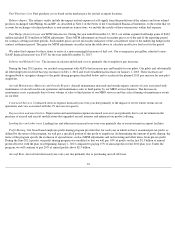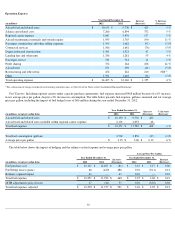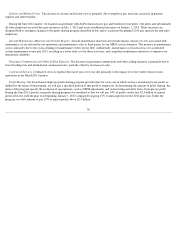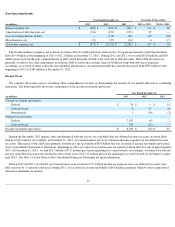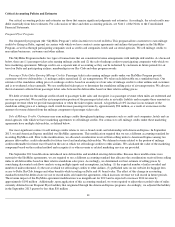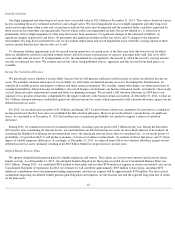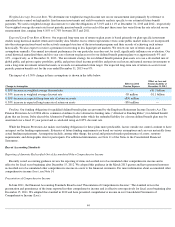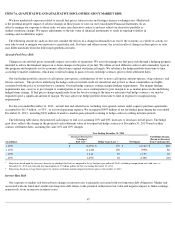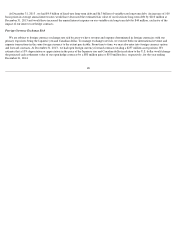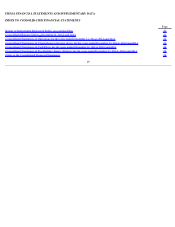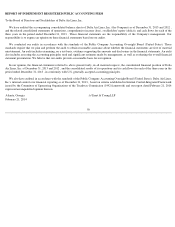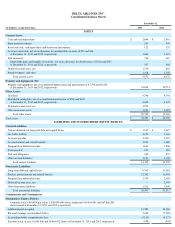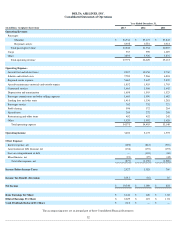Delta Airlines 2013 Annual Report Download - page 49
Download and view the complete annual report
Please find page 49 of the 2013 Delta Airlines annual report below. You can navigate through the pages in the report by either clicking on the pages listed below, or by using the keyword search tool below to find specific information within the annual report.
Long
-Lived Assets
Our flight equipment and other long-lived assets have a recorded value of $21.9 billion at December 31, 2013
. This value is based on various
factors, including the assets' estimated useful lives and salvage values. We record impairment losses on flight equipment and other long-lived
assets used in operations when events and circumstances indicate the assets may be impaired and the estimated future cash flows generated by
those assets are less than their carrying amounts. Factors which could cause impairment include, but are not limited to, (1) a decision to
permanently remove flight equipment or other long-lived assets from operations, (2) significant changes in the estimated useful life, (3)
significant changes in projected cash flows, (4) permanent and significant declines in fleet fair values and (5) changes to the regulatory
environment. For long-lived assets held for sale, we discontinue depreciation and record impairment losses when the carrying amount of these
assets is greater than the fair value less the cost to sell.
To determine whether impairments exist for aircraft used in operations, we group assets at the fleet-type level (the lowest level for which
there are identifiable cash flows) and then estimate future cash flows based on projections of capacity, passenger mile yield, fuel costs, labor
costs and other relevant factors. If an impairment occurs, the impairment loss recognized is the amount by which the aircraft's carrying amount
exceeds its estimated fair value. We estimate aircraft fair values using published sources, appraisals and bids received from third parties, as
available.
Income Tax Valuation Allowance
We periodically assess whether it is more likely than not that we will generate sufficient taxable income to realize our deferred income tax
assets. We establish valuation allowances if it is not likely we will realize our deferred income tax assets. In making this determination, we
consider all available positive and negative evidence and make certain assumptions. We consider, among other things, our future projections of
sustained profitability, deferred income tax liabilities, the overall business environment, our historical financial results, our industry's historically
cyclical financial results and potential current and future tax planning strategies. We recorded a full valuation allowance in 2004 due to our
cumulative loss position at that time, compounded by the negative industry-wide business trends and outlook. At December 31, 2012, we had an
$11.0 billion valuation allowance established against our deferred income tax assets, which represented a full valuation allowance against our net
deferred income tax assets.
For 2012, we recorded a pre-tax profit of $1.0 billion, and during 2012 we moved from a three-year cumulative loss position to a cumulative
income position for the first time since we established the full valuation allowance. However given the industry's recent history of significant
losses, we concluded as of December 31, 2012 that another year of significant profitability was needed to support a release of valuation
allowance.
During 2013, we continued our trend of sustained profitability, recording a pre-tax profit of $2.5 billion for the year. During the December
2013 quarter, after considering all relevant factors, we concluded that our deferred income tax assets are more likely than not to be realized. In
evaluating the likelihood of utilizing our net deferred net assets, the significant relevant factors that we considered are: (1) our recent history of
profitability; (2) growth in the U.S. and global economies; (3) forecast of airline revenue trends; (4) estimate of future fuel prices; and (5) future
impact of taxable temporary differences. Accordingly, at December 31, 2013, we released almost all of our valuation allowance against our net
deferred income tax assets, primarily resulting in the $8.0 billion benefit in our provision for income taxes.
Defined Benefit Pension Plans
We sponsor defined benefit pension plans for eligible employees and retirees. These plans are closed to new entrants and frozen for future
benefit accruals. As of December 31, 2013 , the unfunded benefit obligation for these plans recorded on our Consolidated Balance Sheet was
$10.1 billion . During 2013 , we contributed $914 million to these plans and recorded $354 million
of expense in salaries and related costs on our
Consolidated Statement of Operations. In 2014, we estimate we will contribute approximately $925 million to these plans, including $250
million of contributions above the minimum funding requirements, and that our expense will be approximately $230 million. The most critical
assumptions impacting our defined benefit pension plan obligations and expenses are the discount rate and the expected long-term rate of return
on the plan assets.
43


